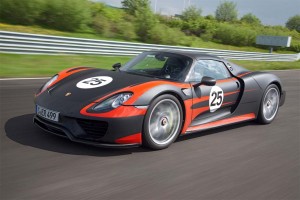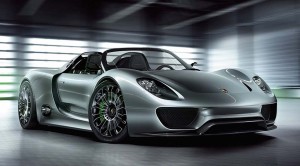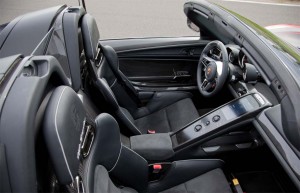For those who think battery-based vehicles are, by nature, slow and boring, the new Porsche 918 Spyder plug-in supercar could deliver a shocking surprise.
True, the carbon-fiber 918 is expected to yield significant improvements in fuel efficiency – and about 18 miles per charge on its lithium-ion battery pack, but it will also launch from 0 to 60 in less than 2.8 seconds. A Chevrolet Volt it definitely isn’t.
The new supercar “demonstrates the potential of the hybrid drive to a degree never seen before: the parallel improvement of both efficiency and performance without one being at the cost of the other,” says Porsche, which first revealed a prototype of the 918 several years ago and is launching the production version this week.
The heart of the 918 Spyder is its distribution of propulsive power from three sources: a 608-horsepower V-8 borrowed from the LMP2 RS Spyder race car, and two electric motors, one on each axle. Together, they produce a maximum total of 884 horsepower – but an intelligent management system can mix-and-match the three power sources to balance traction, performance and fuel efficiency.
Energy for the electric motors is stored in a liquid-cooled lithium-ion battery pack comprising 312 individual cells with an energy content of about seven kilowatt-hours. That’s enough for about 18 miles in battery mode alone. Porsche claims the 918 Spyder can be recharged in about two hours using the Porsche Universal Charger. An optional Porsche Speed Charging Station can cut that to as little as 25 minutes.
The car’s performance has a lot to do with lightweighting. Batteries carry a lot of mass but Porsche was able to hold the weight of the entire supercar down to just 3,715 pounds. The Porsche 918 Spyder features a monocoque and subframe made of carbon fiber reinforced polymer, material Porsche has become increasing familiar with through its racing efforts.
The drivetrain and all components weighing over 110 pounds are located as low and as centrally as possible within the vehicle. This results in a slightly rear-biased weight distribution of 57%, combined with an extremely low center of gravity at approximately the height of the wheel hubs, which Porsche claims is ideal for driving dynamics.
With a 0 to 60 launch time estimated at under 2.8 seconds, the new Porsche 918 is both mean and green, but this isn’t just a straight-line, plug-in muscle car. Testing at the legendary Nurburgring achieved a North Loop lap time of 7:14, Porsche notes, about 20 seconds faster than the maker’s Carrera GT.
For those who plan to push the Porsche 918 Spyder to the limits, the drivetrain features two different race modes: Race Hybrid and Hot Lap. The former delivers the highest level of performance, relying primarily on the gas engine for power and recharging the batteries only sporadically, when power demands are low. But that recaptured energy comes in useful when the driver stomps the throttle, providing the battery equivalent of a turbocharger’s boost for short bursts.
In Race Hybrid mode, the batteries deliver maximum power, albeit for just a few laps.
At the other end of the spectrum, the 918 can be switched into “Hybrid” mode, the electric motors and combustion engine working alternately with a focus on maximum efficiency and minimum fuel consumption, the German maker notes, depending upon the current driving situation and the desired performance.
Like other European makers, Porsche was slow to embrace battery propulsion – at least until recently. It has been rolling out an array of conventional and plug-in hybrids. But the new 918 Spyder is meant to take things to the extreme, the maker promising the new model will contribute to “the gene pool for the Porsche sports cars of the future.”
Porsche isn’t the only maker to see the performance advantages of battery propulsion, however. Earlier this year, Mercedes-Benz introduced the all-electric production version of its SLS AMG supercar. And with the LaFerrari and P1, respectively, Ferrari and McLaren have also turned to plug-in power to deliver the maximum in performance.
Joe Szczesny contributed to this report.





Porsche’s hybrids are anything but boring nor are Audi’s hybrid race cars. That being said I’m guessing that most of these hybrids will end up in museums in the not too distant future.
I did notice the other day that Michelin’s Euro travel map service estimates the price of petrol and electricity for travel via auto, which is pretty funny. Renault is sponsoring the electric information. How many hybrids let alone EVs do you see on the Autobahn? 80% of pass cars used in Europe are Diesel powered. Clean Diesel is the only current affordable tech that can come close to a real world 24/7 54.5 MPG.
Truth be known the car makers are promoting the hybrids to meet the impossible 54.5 mpg CAFE standards as they know there is no way possible to do it any other way. It’s criminal that the braindead politicians in DC can just pull CAFE numbers out of their arses and mandate that auto makers meet these impossible standards.
The honchos at the EPA and Obama should be fired and held accountable for their irresponsible energy dictates based on flawed science.